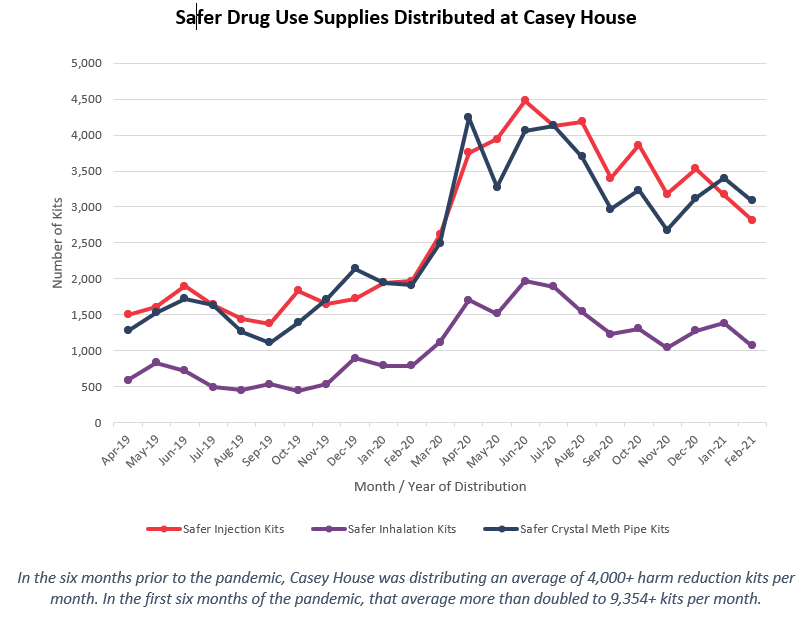By: Myna Kota, Public Policy & Stakeholder Affairs Lead, Casey House
When the COVID-19 pandemic forced many harm reduction and outpatient hospital services to close, Casey House continued to provide 24/7 low-barrier access to safer drug use supplies at its front door in Toronto. For the sub-acute HIV specialty hospital, continuing to operate this essential health service for people who use drugs has been critical given the convergence of the overdose crisis, housing crisis, and the pandemic.
Generally speaking, harm reduction refers to the evidence-based policies, programs and practices that seek to minimize the negative impacts of drug use, and works with people without judgment or requiring that they stop using drugs in order to receive support. Harm reduction often includes health services such as access to safer drug use supplies, safer supply prescribing, and supervised consumption services, but it is much broader than service delivery; meaningful and effective harm reduction requires a philosophy of judgment-free, culturally sensitive and trauma-informed care. Access to these essential services remains a critical gap in many communities and is not yet common in hospital settings.
In partnership with Toronto Public Health, Casey House's harm reduction services have included distributing safer injection and inhalation supplies since 2014, and safer crystal meth supplies since 2018. The aim is to reduce infectious disease transmission and other harms associated with substance use, alongside naloxone kits to reverse overdoses. Continuing to provide access to safer drug use supplies during the pandemic enabled Casey House to identify and respond to evolving community needs:
- Increased Demand: In the six months prior to the pandemic, Casey House distributed an average of more than 4,000 harm reduction kits per month. In the first six months of the pandemic, that average more than doubled to over 9,000 kits each month.
- Peer Support: With more people accessing safer drug use supplies at its front door, Casey House expanded services to include support from peers with lived experience of drug use. Through meaningful conversations, peers connect with individuals picking up supplies and provide additional support and guidance based on each person's need.
With more than 2,000 opioid-related deaths in Ontario in 2020, the need for harm reduction services continues to grow.
Emerging insights for hospitals
Casey House has learned that hospitals have a unique opportunity to contribute to delivering harm reduction services:
Hospital hours and location
While many community health centres, public health units, and organizations that serve people who use drugs distribute harm reduction kits, Casey House's location and safe 24-hour access are key reasons people visit its facility for supplies. Most pick-ups are after 5 p.m. and on weekends, when many local services are not open, and the majority of individuals travel by foot, are not accessing supplies at other locations, and are often picking up kits for more than themselves.
Improving engagement with health
care overall
Many people accessing safer drug use supplies at Casey House are not connected to health care or other harm reduction services, and often ask for information on additional supports such as shelters and naloxone. Training hospital staff and providing safer drug use supplies in a judgment-free environment has yielded several benefits: it communicates openness, encourages people to speak with health care providers about their drug use, and increases the willingness of both clinicians and the people they care for to discuss drug-related harms. Providing a compassionate space for conversation helps build stronger, more honest relationships which have the potential to deepen engagement and trust with health care overall.
Looking ahead
Casey House's experience points to the promise and potential for hospitals to improve health care for people who use drugs by embracing a harm reduction approach – particularly given the increasingly toxic supply of unregulated drugs and the growing risk of overdose. At Casey House, additional research is underway to dig deeper into the impacts of introducing harm reduction initiatives in clinical care settings so it can continue to improve health care for people who use drugs.
For more information, contact Myna Kota at mkota@caseyhouse.ca. To learn more about Casey House, visit https://www.caseyhouse.com/.